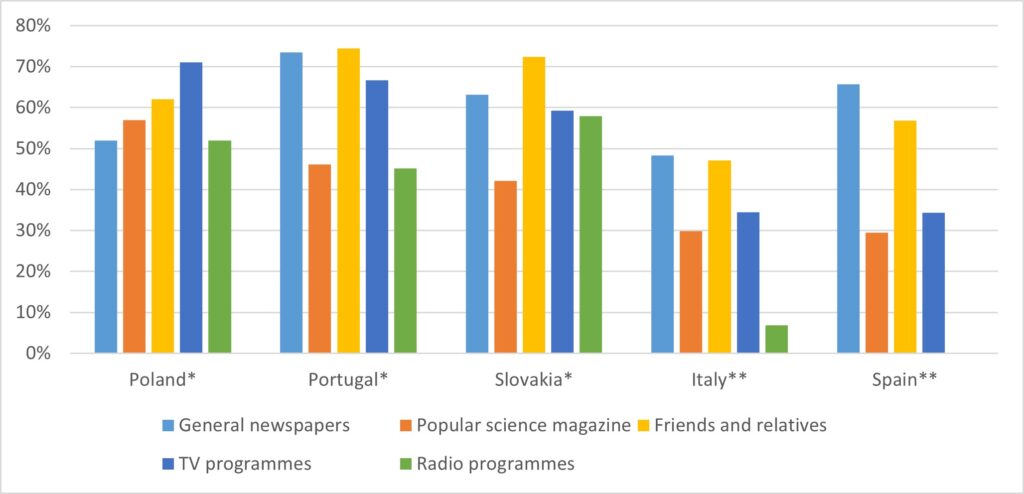As seen in a previous post, the public consultations included a couple of quantitative activities after the discussion of each topic where citizens had to fill in a very short questionnaire. Activities were either focused on general environmental/health issues (Italy, Spain) or on the specific topic of climate change/vaccines (Portugal, Poland, Slovakia).
After addressing the use and trust in sources in the previous instalment, this post will present the results about channels of communication through which citizens access scientific information, in particular digital media and analogical ones.
As for environmental issues (Figure 1), it is clear that most digital platforms are very frequently used to search for or come across scientific information. General websites, information websites and YouTube all register over 50% of responses in all countries. Facebook is particularly popular in Slovakia, Portugal, and Poland. Twitter is used by slightly less than a third of participants in Spain and Instagram seems to be fairly used in Slovakia.
Figure 1. Participants who use digital platforms to search for or access information about environment / climate change at least once a week

*Questionnaire mentions climate change; **Mentions environment
N = 467
However, when it comes to vaccination or health issues, a different picture emerges (Figure 2). First, the use of digital media is in general lower, in particular in Portugal. That either means the topic is not very present in these platforms or that people seldom search about it. Information websites are preferred over general websites in Portugal and Spain (possibly the websites of health authorities) and the reverse happens in Slovakia and Italy. Facebook remains much more popular than other social networks except in Spain (where Twitter is not far behind).
Figure 2. Participants who use digital platforms to search for or access information about health / vaccines at least once a week

*Questionnaire mentions vaccines; **Mentions health
N = 349
Looking now at non-digital media in environmental issues (Figure 3), citizens report a more frequent use of television programmes in Poland, newspapers and conversations with friends family in Portugal and Italy, newspaper in Spain and friends and relations in Slovakia. Again, these results are affected not only by individual preferences but also by media coverage of subjects.
Figure 3. Participants who use non-digital media to search for or access information about environment / climate change at least once a week

*Questionnaire mentions climate change; **Mentions environment
N = 467
In analogical media, once again health issues are less frequently searched for than environmental ones, especially in Portugal (Figure 4). General newspapers are particularly favoured in Italy and Spain, whereas TV is more popular in Portugal and family conversations in Slovakia.
Figure 4. Participants who use non-digital media to search for or access information about health / vaccines at least once a week

*Questionnaire mentions vaccines; **Mentions health
N = 349
In isolation, these quantitative results tell us little. However, the content analysis of the discussions between participants can shed light on the reasons for the preferences and habits of citizens in terms of obtaining scientific information.
Ana Delicado
